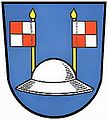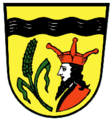Hat (heraldry)
The hat is a common figure in heraldry (heraldry) and has often depicted the fashion of the time in its representation. The starting point was a medieval tin balaclava , but also the hat of the citizens. It appears in the coats of arms / fields in different forms of representation. The color scheme and the combination with herald pictures make it a popular object. The hat can be sprinkled or decorated with things .
description
Not only in the shield, but also as part of the coat of arms , the hat has asserted itself. A distinction can be made here between a mere decorative element and a ranking symbol. The " high hat " is often taken , a long, slim one that becomes narrower towards the top. The pointed hat is therefore often used in the coat of arms and many of the other hats have this as a template. The following examples illustrate the diversity.
The hat has a special status as a symbol of rank. Secular and ecclesiastical dignitaries or princes have a hat that shows their rank hovering over the shield. About the coat of arms in the ecclesiastical heraldry there are, for example, the bishop's miter , cardinal's hat , the Mitra or the Archbishop Shut . Behind the hats, crooks , crosses and weapons such as swords are also placed to enhance their value . A fixed number of tassels hang on the sides of the flat hats of the dignitaries . The color and number are important indicators here. The Kurhut with ermine gauntlet is also a symbol of rank. The hat can also have a fur cuff. The beret or toque is similar to this hat shape. The faceplate often has incisions. The flat Kurhut shape becomes a Bohemian hat with a longer, pleasing round hat tip . Is also so emblazoned . Cowl or hood is an old headgear and is shown in the side view with the open side to the right. This is almost without exception only in color and without any other items. The two-pronged and three pronged fool's hood can also appear in the coat of arms with bells. They are often very colorful. Under a pagan hat , the viewer must imagine a hat with a cuff, the tip of which is curled down like a curl and the cuff is covered with images of heralds. Different colored pearls can be placed on the outer hat edge. If the wrap is up, this hat is called a Phrygian cap . The Eisenhut is also by the shape of its name to the Eisenhutfeh . The shape is available high and flat. Also mentioned in the description if it is an important feature. Similar to the above, only the Jewish hat is more pointed . Other hats are Swiss hats and doctoral hats . A feather is attached to the Swiss hat to distinguish it. It is also called a Tellenhut. This freedom hat is a wide-brimmed felt hat that occurs primarily in Swiss heraldry , often over the canton's coat of arms . An example is the coat of arms of Aargau around 1803. A feather ornament is attached to the hat.
The Tatar hat, usually tapered to a point or bent over, has been in use since the 16th century. It is also known as the Albanian and Hungarian hat. The term Heidenhut is also used for it. A cuff made of ermine, as well as a tassel or tassel on the top of the cap characterize this heraldic headgear. The appearance can vary. Use in the coat of arms as a common figure or as a helmet ornament in the upper coat of arms . In real life, this hat was also called Tafja and should not have been removed at home. The Mortar is in many cases the educational level of the wearer. Even if the crown and helmet are not hats, they are headgear and should be briefly mentioned here. They are inextricably linked with the hat. There are crown-decorated hats and a hat is placed on some helmets as a crest ornament. Also crowns and helmets are in the escutcheon alone or heraldic animals placed shown. The heralds then emblazoned crowned or helmeted . Birds with snake necks (swan, crane ...) often have the crown pulled over their necks. The use in the coat of arms is the more important function of these headgear.
Examples
Gold-crowned, hermelin-trimmed silver cap, studded with ostrich feathers
Also with feather headdress : Cureglia
Tripod cap
three Tatar hats in the coat of arms of the von Kitzing family
Gauntlet in the coat of arms of Zinzenzell
Kettle hat in the coat of arms of Framersheim
Three red balaclavas: Seon
See also
Web links
Individual evidence
- ↑ Gert Oswald : Lexicon of Heraldry. VEB Bibliographisches Institut, Leipzig 1984.
















